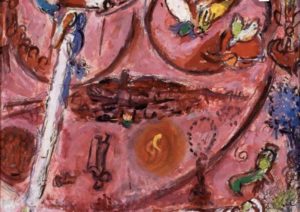
“Song of Songs,” (1960) Panel III, Marc Chagall National Museum, Nice, France.
Passover has many beloved traditions. The holiday begins with the gathering of families and the reading of the Haggadah. Soon as Pesach ends, traditional Jews begin studying Pirkei Avot “Ethics of the Fathers” (or, alternatively, “Principle Teachings”), a masterful collection of wise sayings in a unique tractate of the Talmud. During the Shabbat of Passover, it is customary to read “The Song of Songs,” a unique Biblical book of poetry of love poetry attributed to King Solomon who ruled in Jerusalem during the 10th century BCE. Perhaps, the most famous line from “Song of Songs” in Hebrew is “dodi li va’ani lo” or “I am my beloved’s and my beloved is mine.” Often this verse is used as an alternative ring vow in Jewish weddings.
While scholars continue to debate the date and authorship of the “Song of Songs,” no one contests its place as one of the great love poems in this history of human literature. Written from both male and female perspectives, it captures the passion of young love and courtship against the background of ancient, royal Jerusalem and its palaces and gardens. The rabbis long debated its canonicity but finally decided in the second century CE to include it as a Biblical text understood as an allegory of the love between God and Israel. For that reason, Song of Songs became mandated reading during Passover, itself a narrative of the young relationship between the people or Israel and its heroic God. A plain reading of the Biblical poetry would suggest something more human and sensuous but luckily, the sages had the wisdom to preserve the poetry of young suitors in Jerusalem for the ages.
Several years ago, Liz and I had the privilege of visiting the National Marc Chagall Museum in Nice, France. Included in its collection, the largest Chagall collection in the world is not only his work on Genesis and Exodus but five masterful panels on the “Song of Songs.” My favorite, Panel III, is posted above with the city of Jerusalem at the center, a swooning bride and groom, King David and his magical harp and an assortment of Jewish sacred symbols so frequently employed by Chagall. Chagall (1887-1985) is actually buried nearby in an acropolis cemetery in Saint-Paul-de-Vence, which we also visited. Like his famous Hadassah Windows and Keneseth Tapestries, Chagall brings the history and heritage of the Jewish people to life through amazing colors, symbols and fanciful images.
In his interpretation of the “Song of Songs,” Chagall successfully brings to life the powerful meaning of the word “beloved.” Our lives are made meaningful by those we love. If we are lucky, we have a cluster of truly beloved people in our lives beginning in our childhoods and continuing through old age. Beloved memories, too, bring richness and solace to our days. In a spiritual sense, Passover is an ongoing tale of the love relationship between the Jewish people, its heritage and its God, however we understand God. No holiday gives us the opportunity to share family love and love of tradition better than Passover. Thus, the rabbis were wise, indeed, to include, the reading of the Song of Songs as a Passover tradition.
I hope that your Seders this year, whether live or on zoom, were filled with family love and including the loving embrace of many of our most beloved traditions. I know our family Seder and the second night congregational Seder both made the mark for me. My prayer is that for next year, we will be able to end our Seders by saying, “next year may we all be together, next year may we be able to attend Seder at KI, next year may the city of Jerusalem know peace and its sanctity illumine Jewish life all over the world.” Meanwhile, stay emotionally and spiritually close to all who you love and may that love give you strength and peace.
Shabbat Shalom and Happy Passover!
Rabbi Lance J. Sussman, Ph.D.
